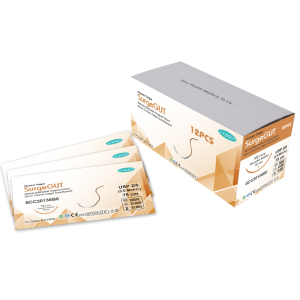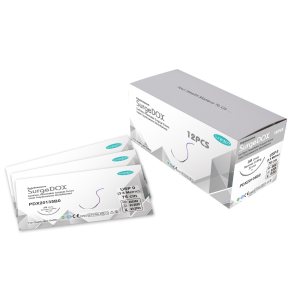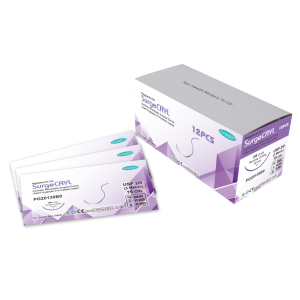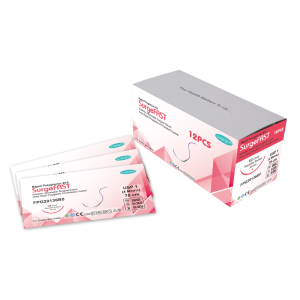Description
Suture Substance Suture Substance
Synthetic, sterile, absorbable sutures made of polyglycolic acid (PGA) are available with or without needles. It has been discovered that polyglycolic acid (PGA), when coated with polycaroplactone and calcium stearate, is inserted, non-antigenic, and non-pyrogenic. The sutures are braided and come in beige or violet-colored varieties. Polyglycolic acid (PGA) satisfies the standards of the European Pharmacopoeia (EP) for sterile synthetic absorbable surgical sutures and the United States Pharmacopoeia (USP) for synthetic absorbable surgical sutures with or without needles.
Instructions for Use Instructions for Use
It isn’t intended to be used for cardiovascular or neurological treatments, but rather for general soft tissue approximation
Actions Actions
Polyglycolic acid (PGA) leads to minimal tissue response and fibrous connective tissue growth. The breakdown of absorbable or bio-absorbable sutures happens through hydrolysis, where PGA degrades into glycolic acids that the body absorbs and metabolizes. The process begins with reduced tensile strength followed by mass loss. Testing indicates that PGA maintains about 65% of its initial tensile strength two weeks after implantation. The absorption of PGA is nearly fully done.
Contraindications Contraindications
The use of absorbable Polyglycolic acid (PGA) sutures is not recommended in situations where there is a need for long-lasting tissue approximation under stress. Additionally, these sutures should be avoided in patients who have known sensitivities or allergies to their components.
Warning Warning
The Polyglycolic acid (PGA) suture is sterilized using ethylene oxide gas and is intended for single use only. It should not be re-sterilized or used if the package has been opened or damaged. Open and unused sutures should be discarded. It is important to store the sutures at room temperature and avoid prolonged exposure to high temperatures and moisture. Therefore, users should have a good understanding of surgical procedures and techniques. Prior to using Polyglycolic acid (PGA) for wound closure, it is important to consider the use of absorbable sutures, as the risk of wound dehiscence may differ depending on the site of application and the type of suture material used. When tying the suture thread, it should be tightened securely. The recommended length for the end of the thread is greater than 0.5mm. The part of the needle that is held is specifically designed, and it should not be altered, as any changes may result in damage to the needle’s point or sharp edge. Polyglycolic acid (PGA) sutures may not provide optimal wound closure in elderly, malnourished, or debilitated patients, as well as in patients with conditions that can delay wound healing. Since PGA is an absorbable suture material, the surgeon should consider using additional absorbable sutures to provide adequate closure for sites that may experience expansion, stretching, or distention, or those that require extra support.
Precautions Precautions
In specific situations, particularly during orthopaedic procedures, surgeons may opt for external support immobilization. Skin sutures that need to remain in place for over 7 days can lead to localized irritation and should be removed accordingly. When dealing with Polyglycolic acid (PGA) sutures or any other suture materials, it's essential to handle them with care to prevent damage. Avoid mishandling that might cause crushing or crimping due to surgical instruments like forceps or needle holders. Achieving secure knots necessitates employing accepted surgical techniques, employing flat, square knots, and adding extra throws as required by the surgical context and surgeon's expertise. The use of additional throws is especially relevant during knotting.
Adverse Reactions Adverse Reactions
Adverse reactions related to the use of this device include wound dehiscence (separation of wound edges), inability to adequately support wounds in areas where expansion, stretching, or distension occurs, insufficient wound support in elderly individuals. Malnourished or debilitated patients, or those with conditions that may impede wound healing, wound infection, Minimal acute inflammatory tissue reaction, Localized irritation when skin sutures are left in place for more than 7 days, Formation of calculi (stones) in the urinary and biliary tracts when prolonged contact with salt solutions like urine and bile happens, Temporary local irritation.
Storage Storage
Store packed product at temperature not more than 40℃.Avoid from moisture and direct heat. Do not use after date of expiry!
Brand Name Length Size
| Brand Name | Suture Material | Length | Size | |||||||||||
| SurgeCOL | Polyglycolic Acid |
|
|















